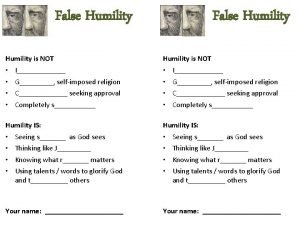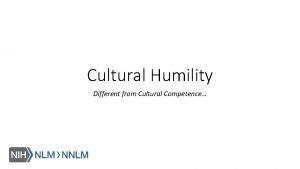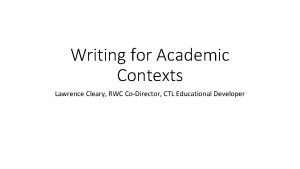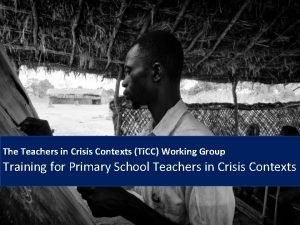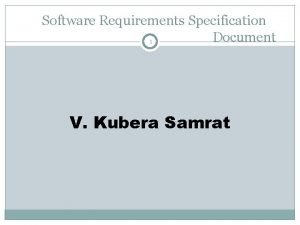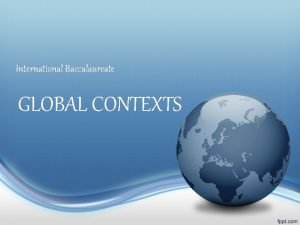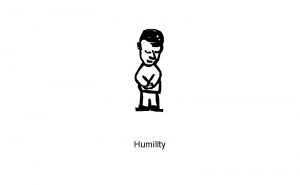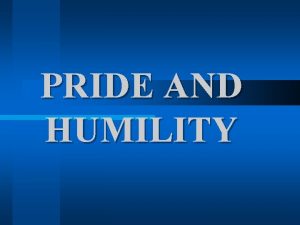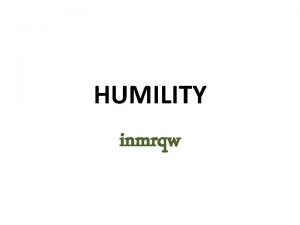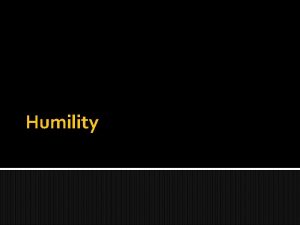Cultural Humility in Higher Education Contexts The Essence






![Moving Forward with Intention – Guiding Principles Cultural Humility “[the] ability to maintain an Moving Forward with Intention – Guiding Principles Cultural Humility “[the] ability to maintain an](https://slidetodoc.com/presentation_image/87769d617a34df88019bd7cf775bfdca/image-7.jpg)



- Slides: 10

Cultural Humility in Higher Education Contexts – The Essence of Ethical, Principled Leadership AIE 2017 Amsterdam Dr. Colleen Kawalilak Associate Dean International Werklund School of Education Calgary, CANADA

Uof. C International Strategy § Uof. C International Strategy - Goal 1: Increase diversity of our campus communities - Goal 2: To improve global and cross cultural competencies within our campus communities - Goal 3: Enhance opportunities for international collaborations and partnerships in research and education - Goal 4: Leverage our unique areas of expertise to engage in international development

Goal 2 *Internationalization Task Force on Cross/Intercultural Competencies Created to address Goal 2: To improve global and cross cultural competencies within our campus communities The Task Force positions itself at the intersection of a number of initiatives on campus that focus on deepening and enhancing cross/intercultural competencies.

Mandate – Internationalization Task Force § Determine cross-cultural competencies required for the University of Calgary § Determine internal standards for international competencies (cross-cultural or intercultural competencies and international research competencies) § Perform an audit of existing cross-cultural competencies (students, staff, faculty, and graduates) to establish a baseline and perform a gap analysis § Target deficiencies and operationalize expected outcomes

Cross-Cultural Competencies I, III Human impact on worldwide systems Understanding Global Connections and Cultural Differences Inequities and injustices related to gender, race, nationhood, religion, age, class Compare hierarchies and inequalities embedded in culture Relation between language and social context Interdependency of worldwide systems (natural and built) Power structures across time and space Cultural differences in local and global contexts Understanding language as shaping values and beliefs Linkage between language and non-verbal behaviours Historical legacies shape knowledge, individuals, and values Bridge cultural differences to reach common goals Understanding cultures as constantly changing Communicating Across Cultures Traverse cultural boundaries Appropriate intercultural communication Analyzing Cultures and Valuing Diversity Critical self reflection regarding one’s own culture Respect multiple cultural perspectives Understanding cultures as existing in contexts

Traditional Focus Regardless of how one shifts the lens, the focus remains: - Recruitment of international students - Study abroad/travel study programs - Agreements (joint degrees/cotutelle agreements) Advancing the “Pause” and “Reflective Practice”— § Creating spaces for dialogue – leaning into difficult conversations (what are some difficult conversations? ) § Principles that guide our work
![Moving Forward with Intention Guiding Principles Cultural Humility the ability to maintain an Moving Forward with Intention – Guiding Principles Cultural Humility “[the] ability to maintain an](https://slidetodoc.com/presentation_image/87769d617a34df88019bd7cf775bfdca/image-7.jpg)
Moving Forward with Intention – Guiding Principles Cultural Humility “[the] ability to maintain an interpersonal stance that is other-oriented (or open to the other) in relation to aspects of cultural identity that are most important to the [person]” (Hook, Davis, Owen, Worthington, & Utsey, 2013, p. 2). … focuses on an interactive, process-oriented approach to competency (seeks to “understand” versus “inform”) Factors— § Lifelong commitment to self-evaluation and self-critique (requires openness and ongoing flexibility a responsiveness – we are never “done”—never “competent) § Desire to fix power imbalances (we each bring something of value— collaborating and learning from one another) § Develop partnerships with people/groups who advocate for others—includes advocating within larger organizations in which we participate as cultural humility is larger than ourselves – we must advocate for it systemically *Reference: Tervalon & Murray-Garcia (1998)

Global Health Research

Leading with Intention § Moving forward by stepping back Identifying and making transparent Guiding Principles § An ongoing, fluid process Revisiting Guiding Principles (adjust as needed) § Creating spaces to deepen cultural humility opportunities and practices Reflective practice is a legitimate “Action Item” § Advancing Internationalization at Home (Ia. H) A sub-set of Internationalization of the Curriculum (Io. C) Examples …

References Hook, J. N. , Davis, D. E. , Owen, J. , Worthington Jr. , E. L. , & Utsey, S. O. (2013). Cultural humility: Measuring openness to culturally diverse clients. Journal of Counseling Psychology. doi: 10. 1037/a 0032595 Tervalon, M. , & Murray-Garcia, J. (1998). Cultural humility versus cultural competence: A critical distinction in defining physician training outcomes in multicultural education. Journal of Health Care for the Poor and Undeserved, 9, 117 -125. University of Calgary International Strategy (2013). Retrieved from http: //www. ucalgary. ca/uci/files/uci/ucalgary-international-strategy. pdf
 Humility meaning
Humility meaning Three principles of cultural humility
Three principles of cultural humility Erika carr
Erika carr Fnha cultural safety and humility
Fnha cultural safety and humility Trans umbrella diagram
Trans umbrella diagram What is professional context
What is professional context Writing in academic contexts
Writing in academic contexts Teachers in crisis contexts
Teachers in crisis contexts What sociological perspective stresses that age
What sociological perspective stresses that age The srs document is useful in various contexts:
The srs document is useful in various contexts: Global context orientation in space and time
Global context orientation in space and time
